French Garlic Soup
Delicate yet powerful, French Garlic Soup is a humble, elegant dish that speaks to the soul of traditional French country cooking. It transforms a few simple ingredients—garlic, sage, broth, and homemade mayonnaise—into a bowl of silky, aromatic comfort.
The garlic, softened and mellowed through gentle simmering, infuses the broth with warmth and depth, while the emulsion of egg and oil adds richness and body without heaviness. It’s a soup that feels both ancient and timeless—nourishing, refined, and quietly luxurious.
Ideal for cool evenings or moments of introspection, this dish invites you to slow down and savor every spoonful.
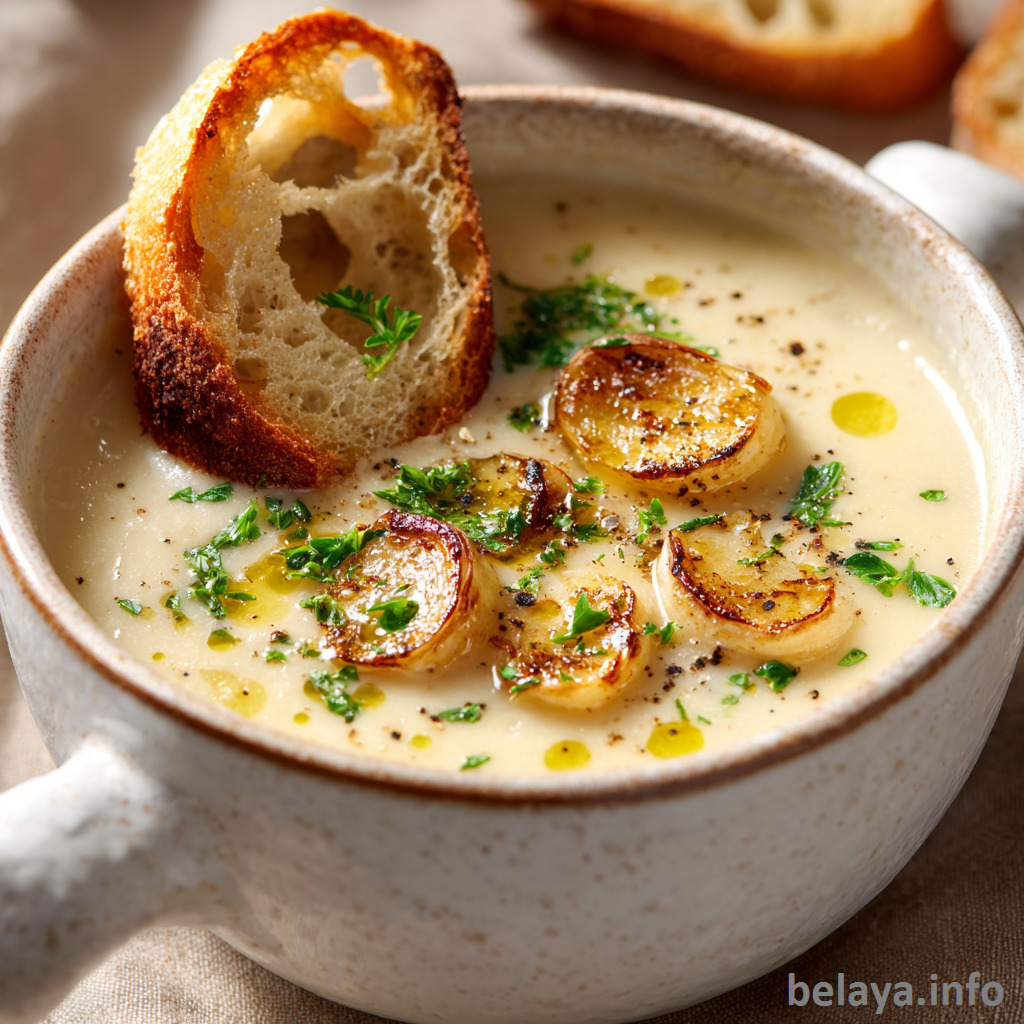
Why People Will Love This French Garlic Soup:
A Celebration of Simplicity: With just a handful of humble ingredients, this soup creates something unexpectedly elegant and deeply flavorful—proof that less can truly be more.
Garlic as a Star Ingredient: The slow simmering and gentle treatment of garlic transforms its sharp bite into a mellow, buttery richness that warms the soul without overwhelming the palate.
Silky Texture with a Rustic Soul: The addition of homemade mayonnaise adds a velvety body to the broth, blending rustic tradition with refined technique in a way that feels both comforting and elevated.
Rooted in Tradition: Inspired by old-world French peasant cooking, this soup connects us to culinary history—a dish shaped by resourcefulness, care, and time.
Naturally Nourishing: Rich in antioxidants from garlic and made with clean, whole ingredients, it’s both soothing and good for the body—especially during cold weather or moments of fatigue.
Customizable and Elegant: Serve it with crusty bread, a drizzle of olive oil, or a dusting of smoked paprika—it adapts beautifully from a rustic farmhouse meal to a refined dinner starter.
Invites Stillness and Slowness: This is not fast food—it’s a soup to be savored, encouraging a pause in the day and appreciation for warmth, simplicity, and depth.
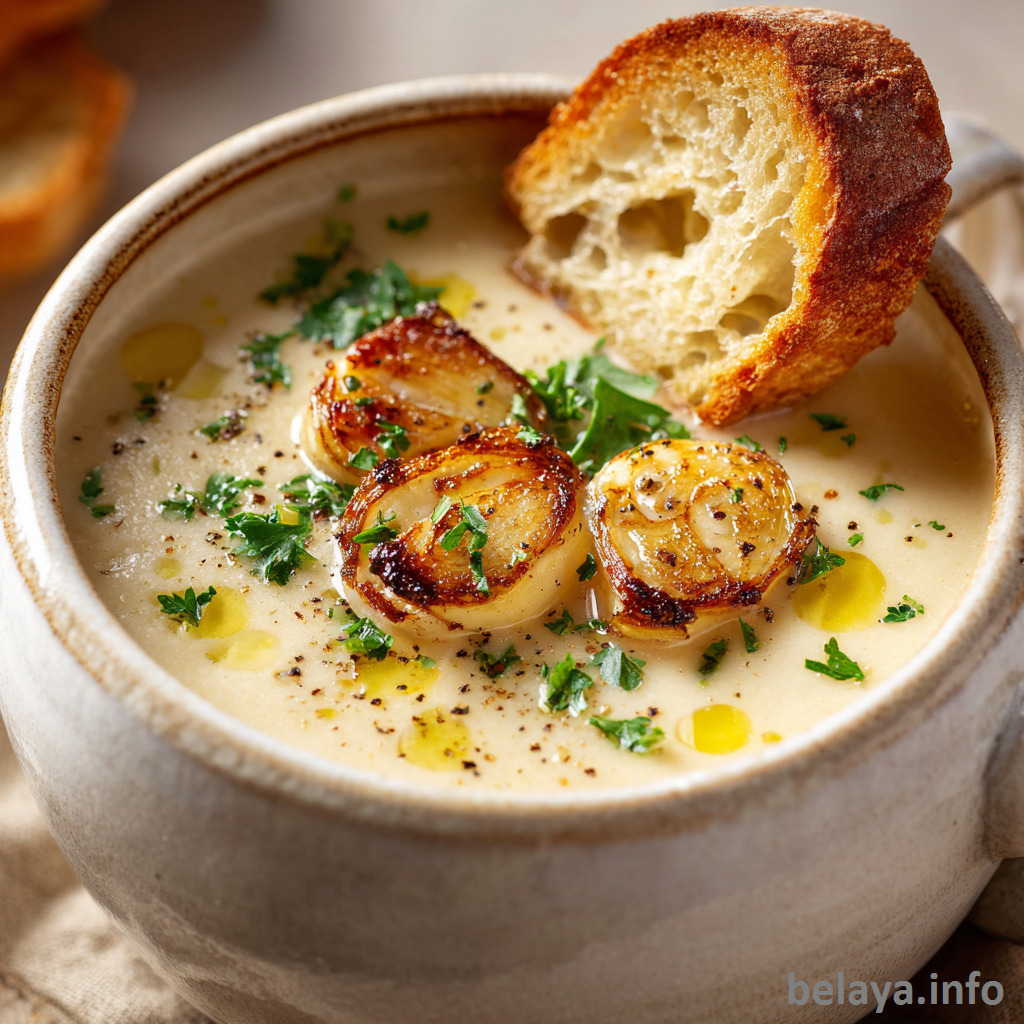
Key Ingredients:
Garlic (1 large head) – The heart of this soup. When gently boiled and mashed, garlic sheds its harshness and transforms into something mellow, nutty, and deeply aromatic. It infuses the broth with warmth and earthy sweetness, proving that even the humblest bulb can create profound flavor.
Chicken Stock (64 oz) – A foundational element that cradles every other ingredient. Its savory depth gives body to the soup while allowing the garlic to shine. A good-quality stock elevates the dish from simple to soul-satisfying.
Fresh Sage – Earthy, piney, and softly peppery, sage lends subtle herbal complexity. Simmered in the broth, it imparts a grounding fragrance that lingers beneath the surface of each spoonful.
Olive Oil (or neutral oil) – Not just a fat, but a carrier of richness. Blended into the egg yolk, it creates a luscious, creamy emulsion that thickens and enriches the broth without using cream or flour.
Egg Yolk – The base of the homemade mayonnaise, it brings structure and silkiness to the soup. Gently tempered, it merges with the broth to create a smooth, luxurious texture.
Dijon Mustard – Just a teaspoon, yet vital. It adds sharpness and depth to the mayo, enhancing the garlic’s sweetness with a subtle edge of acidity and warmth.
Salt – A simple but critical player, it lifts and balances the flavors—bringing harmony to garlic’s depth, sage’s earthiness, and the broth’s body.
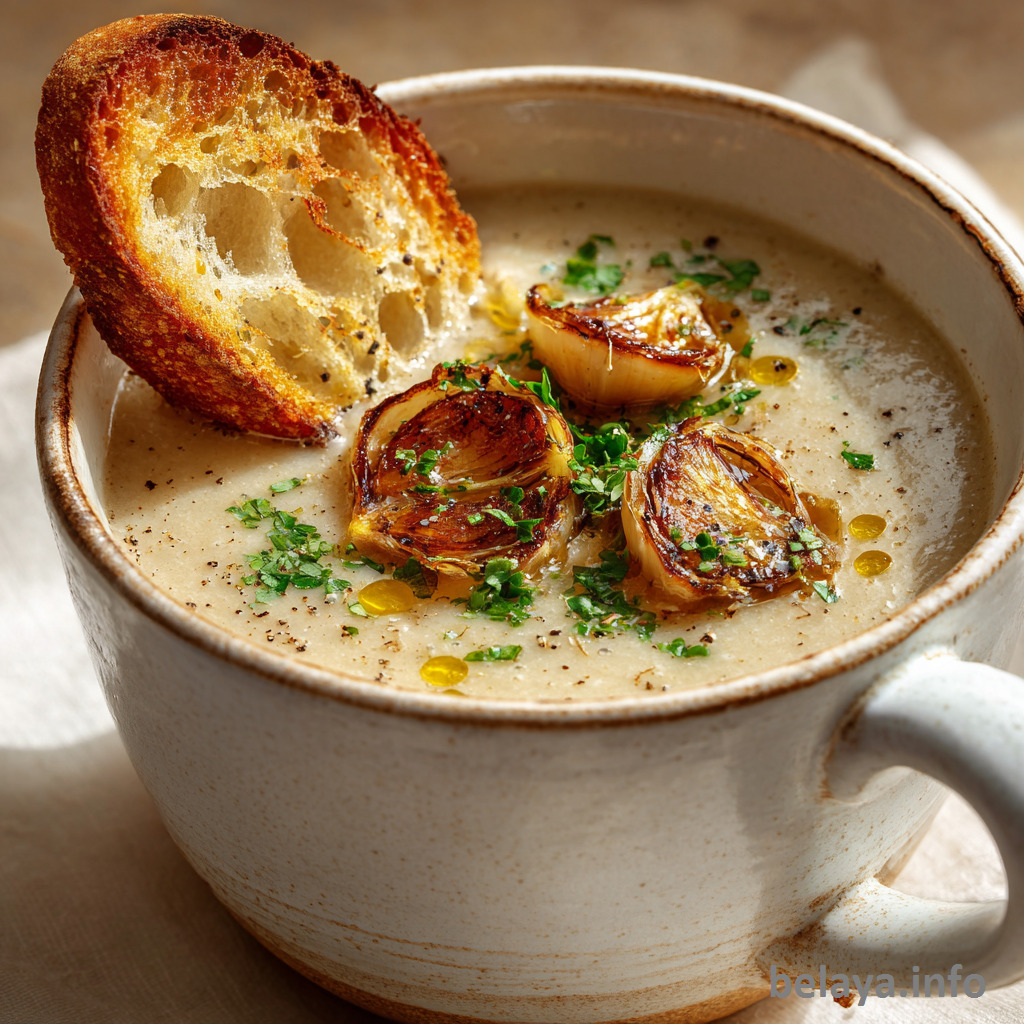
Expert Tips:
Choose the Right Garlic
Use fresh, firm heads of garlic with tight skins. Avoid sprouted or soft cloves—older garlic can taste acrid or overly sharp. The fresher the garlic, the sweeter and silkier the result after simmering.
Remove the Inner Germ for Smooth Flavor
Always slice the garlic in half lengthwise and remove the green inner shoot (germ). This part can be bitter, especially in large quantities, and will interfere with the soup’s mellow character.
Blanch the Garlic for Gentleness
Briefly boiling the garlic before mashing reduces harshness and preserves its subtle complexity. This step is essential for developing that soft, rounded garlic flavor typical of traditional French preparations.
Use High-Quality Stock
Because the broth is the canvas for everything else, homemade or good-quality store-bought chicken stock makes a major difference. Low-sodium options are best to control seasoning.
Take Your Time Mashing the Garlic
Don’t rush this step. Finely mashed garlic dissolves better into the broth, creating a more uniform texture and even distribution of flavor.
Emulsify the Mayonnaise Correctly
For perfect mayonnaise, use a narrow jar and immersion blender. Start with the blender at the bottom and slowly raise it once the mixture starts emulsifying. If it breaks, add the reserved egg white and blend again.
Temper the Mayonnaise Slowly
Avoid curdling by gently whisking in hot broth a spoonful at a time into the mayo before adding it to the pot. This gradual warming keeps the emulsion stable when introduced to the soup.
Do Not Boil After Adding Mayo
Once the mayonnaise is added, never let the soup come to a boil—heat it gently to preserve the creamy, velvety texture and prevent the emulsion from separating.
Strain for a Refined Finish (Optional)
For a silkier mouthfeel, pass the soup through a fine-mesh sieve before adding the tempered mayo. This extra step removes solids and enhances elegance.
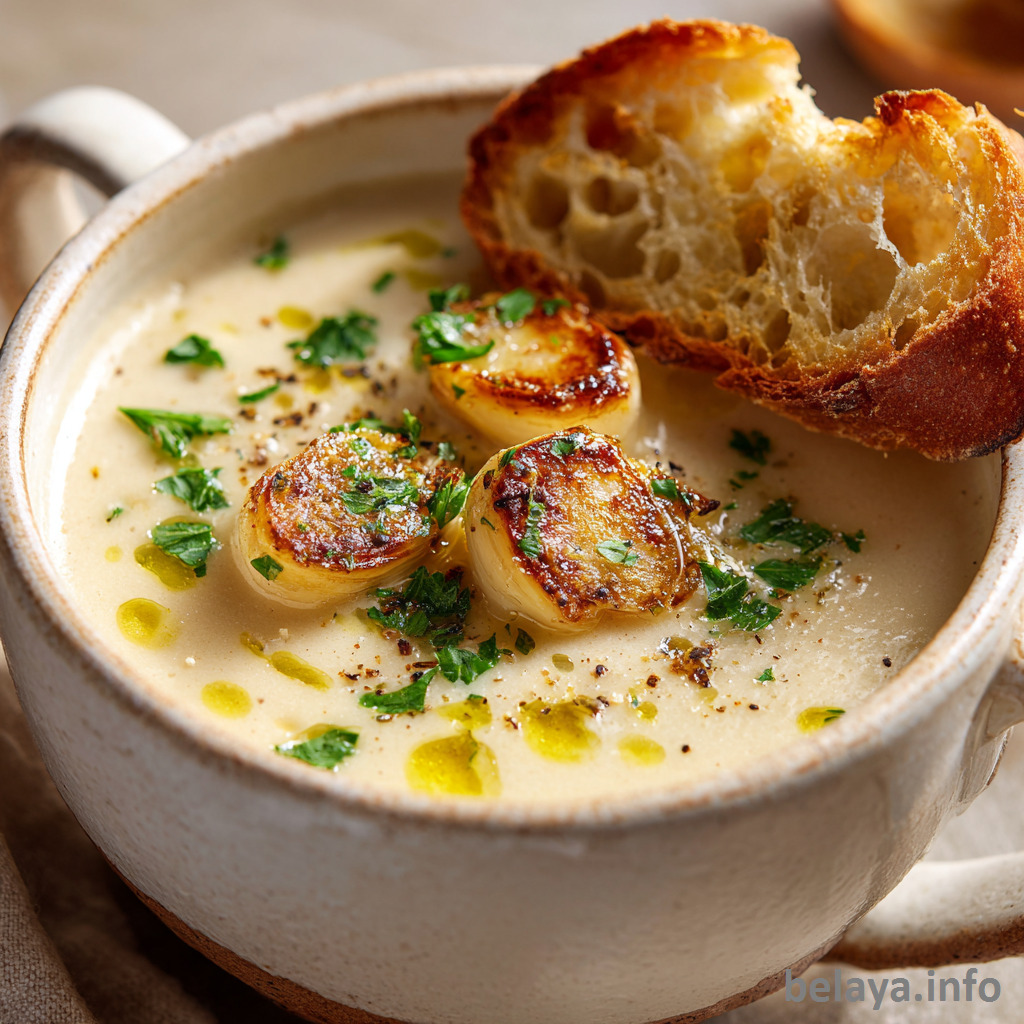
French Garlic Soup
Iingredients
For the Soup:
64 ounces (8 cups) chicken stock or broth
1 small bunch fresh sage leaves
1 large head of garlic, cloves peeled and halved
For the Homemade Mayonnaise:
2/3 cup olive oil (or another neutral oil of your choice, such as grapeseed or sunflower)
1 large egg, yolk and white separated
1 teaspoon Dijon mustard
Pinch of salt
Instructions:
In a large Dutch oven or stockpot, add the chicken stock and fresh sage. Bring to a gentle simmer over medium heat. While it simmers, prepare the garlic.
Peel all the garlic cloves and slice them in half lengthwise. Carefully remove the small inner sprout from each clove using a sharp knife or toothpick—these shoots can be bitter, especially in garlic-heavy dishes.
Bring a small saucepan of water to a boil. Add the peeled garlic cloves and boil for 3–4 minutes. Drain the garlic and set aside.
Using the back of a fork, mash the softened garlic until smooth and paste-like. Take your time to achieve a fine texture. Add the mashed garlic to the simmering stock and let it cook gently for 10 more minutes.
While the soup simmers, make the mayonnaise. In a narrow jar (just wide enough for an immersion blender), combine the egg yolk, Dijon mustard, pinch of salt, and oil. Save the egg white in case you need it later.
Place the immersion blender at the bottom of the jar and blend without moving for a few seconds. Slowly raise the blender as the mixture emulsifies. If it doesn’t thicken right away, add the egg white and blend again until the mayonnaise becomes smooth and creamy.
(Optional) If you prefer a silky-smooth soup, strain the broth through a fine mesh sieve and return it to the pot.
To temper the mayonnaise, ladle a small amount of the hot soup into it and stir well. Then slowly whisk the tempered mayo into the soup pot, stirring constantly to combine.
Warm the soup gently over low heat, just until heated through. Do not boil, as this may cause the mayonnaise to curdle.
Serve hot, topped with crusty croutons, a drizzle of olive oil, a pinch of smoked paprika, and fresh parsley if desired.
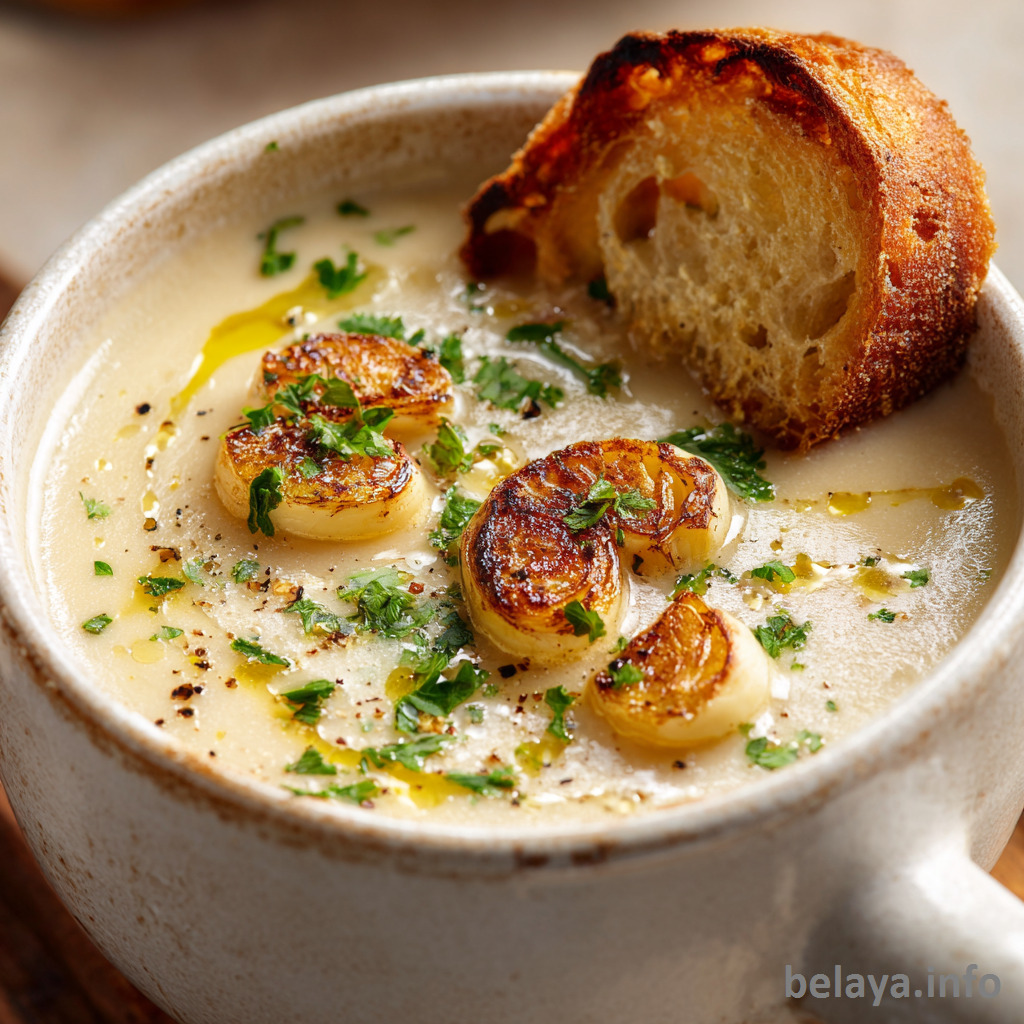
Important Notes When Making French Garlic Soup:
This Is a Subtle Soup—Balance Is Critical
French Garlic Soup is not meant to overwhelm. It walks a fine line between rich and restrained. Every element—garlic, sage, broth, and mayonnaise—must be in harmony. Overuse of any one ingredient can throw off the entire character of the dish.
The Texture Comes from Technique, Not Cream
Unlike creamy soups thickened with flour or dairy, this soup relies on a delicate emulsification of egg yolk and oil to achieve its velvety texture. It’s fragile—heat must be carefully managed to prevent curdling or separation.
Gentleness Is Key at Every Step
From simmering the garlic to blending the mayo and reheating the final soup, gentle handling preserves flavor, texture, and the refined soul of the recipe. Rushing the process will result in bitterness, broken emulsions, or dull broth.
Ingredient Quality Is Non-Negotiable
With so few ingredients, the flavor hinges entirely on the quality of each one. Use fresh, aromatic garlic, fragrant sage, a rich, clean chicken stock, and good olive oil or a neutral oil you trust.
Mayo Isn’t Just a Topping—It’s a Structural Component
The homemade mayonnaise isn’t optional garnish—it’s a central part of the soup’s body. It adds weight, creaminess, and silk to an otherwise light broth. Be sure it’s fully emulsified and well-tempered before incorporating.
Letting the Soup Rest Enhances Flavor
After the final whisking, let the soup sit for 5–10 minutes off heat. This rest allows flavors to settle, the texture to stabilize, and the garlic to mellow into its final, buttery form.
Season Gradually and Thoughtfully
Don’t over-salt at the beginning. The broth may concentrate as it simmers, and the mayo may already contain salt. Taste near the end and adjust with a delicate hand to preserve its gentle character.

How To Enjoy French Garlic Soup After Cooking:
Let It Settle Before Serving
After finishing the soup, let it rest off the heat for 5–10 minutes. This allows the emulsion to fully stabilize and the garlic flavor to gently round out.
Stir gently just before serving to redistribute any settled elements and maintain the soup’s velvety consistency.
How to Serve It Best
Temperature matters: Serve the soup warm—not piping hot—to preserve the integrity of the mayonnaise and keep the flavor soft and smooth. Avoid reheating to a boil, as this can break the emulsion.
Use shallow soup bowls to allow the aromatics (sage, garlic, and olive oil) to lift and release with each spoonful.
Perfect Garnishes & Accompaniments
Crusty bread or croutons: A toasted slice of baguette or rustic country bread adds texture and acts as the perfect vehicle for soaking up the broth.
Olive oil drizzle: A light swirl of good-quality extra virgin olive oil on top adds aroma and richness.
Smoked paprika or freshly cracked pepper: A pinch adds warmth, depth, and visual contrast.
Fresh herbs: Sprinkle a few fresh parsley leaves or a light dusting of chopped chives for freshness and color.
Lemon zest or wedge (optional): A tiny splash of brightness can cut the richness and awaken the palate.
Pairing Suggestions
Wine: Pair with a crisp white wine like Sauvignon Blanc or a light French Chardonnay to match the soup’s elegance without overwhelming it.
Light salad: Serve with a side of simple greens dressed in a vinaigrette to balance the soup’s creamy richness.
Cheese board: A small plate of soft cheeses (like Brie or goat cheese) and fresh fruit offers a refined contrast and rounds out a light meal.
Storing and Reheating
Storage: Keep leftovers in an airtight container in the refrigerator for up to 3 days. Do not freeze, as the emulsion will likely break.
Reheating: Warm gently over low heat, stirring often. Never let it boil. If it begins to separate, blend briefly with an immersion blender to bring it back together.

Nutrition Information
Per 1 cup serving of French Garlic Soup (including the homemade mayonnaise), presented in the requested format:
Calories: 120 kcal | Total Fat: 9.4 g | Saturated Fat: 1.4 g | Monounsaturated Fat: 6.3 g | Polyunsaturated Fat: 1.2 g | Cholesterol: 25 mg | Sodium: 290–350 mg (depending on stock and added salt) | Total Carbohydrates: 5.2 g | Dietary Fiber: 0.6 g | Sugars: 1.4 g | Protein: 3.6 g

Frequently Asked Questions:
Can I make the soup ahead of time?
Yes, but for best texture, make the broth and garlic base ahead, and prepare the mayonnaise fresh when you’re ready to serve. If you need to store leftovers with the mayo already mixed in, reheat gently over low heat to avoid curdling.
What should I do if my mayonnaise doesn’t emulsify?
If the mayo doesn’t thicken after blending, add the reserved egg white and blend again. Using a narrow jar and starting with the blender at the bottom helps ensure the emulsion forms properly.
Can I use store-bought mayonnaise instead of making it from scratch?
Technically yes, but homemade mayo adds a much silkier, more delicate texture. If using store-bought, choose one with minimal seasoning and whisk it with a small amount of warm broth to temper before adding to the soup.
Is this soup vegetarian-friendly?
Not as written—it uses chicken stock. However, you can easily make it vegetarian by swapping in vegetable broth. The garlic and sage still deliver plenty of depth and character.
Can I freeze this soup?
It’s not recommended. The emulsified mayo base can separate and become grainy when frozen and reheated. For best results, enjoy fresh or within 2–3 days stored in the refrigerator.
Why do I need to remove the garlic’s inner sprout?
The inner green sprout (germ) can taste bitter, especially when using a large amount of garlic. Removing it ensures the soup’s flavor stays mellow, sweet, and smooth instead of sharp or harsh.
What’s the purpose of boiling the garlic before mashing?
Briefly boiling the garlic softens its texture and tones down its pungency. This step is crucial for achieving the delicate, buttery flavor that defines this soup—it transforms raw garlic into something gentle and aromatic.
How do I prevent the mayonnaise from curdling in the soup?
The key is tempering: gradually mix a ladle of hot broth into the mayonnaise while whisking constantly. Then slowly add the warmed mayo into the soup. Never boil the soup after adding mayo—heat it gently over low heat to keep the emulsion stable.
What if I don’t have an immersion blender to make the mayo?
You can use a regular blender or a food processor—just be sure to add the oil slowly in a steady stream while blending the egg yolk and mustard to create the emulsion. The container must be narrow enough for the mixture to catch and thicken properly.
Should I strain the soup before adding the mayo?
Straining is optional but highly recommended for a refined, silky finish. It removes any bits of sage, garlic fiber, or loose particles, allowing the emulsion to integrate seamlessly and giving the soup a more elegant texture.